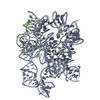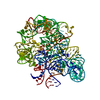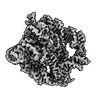[English] 日本語
 Yorodumi
Yorodumi- EMDB-24281: 5 prime exon-free pre-2S intermediate of the Tetrahymena group I ... -
+ Open data
Open data
- Basic information
Basic information
| Entry |  | ||||||||||||||||||
|---|---|---|---|---|---|---|---|---|---|---|---|---|---|---|---|---|---|---|---|
| Title | 5 prime exon-free pre-2S intermediate of the Tetrahymena group I intron, symmetry-expanded monomer from a synthetic dimeric construct | ||||||||||||||||||
 Map data Map data | 5 prime exon-free pre-2S intermediate of Tetrahymena group I intron, symmetry-expanded monomer from a synthetic dimeric construct | ||||||||||||||||||
 Sample Sample |
| ||||||||||||||||||
 Keywords Keywords | Ribozyme / Group I intron / catalytic RNA / RNA | ||||||||||||||||||
| Biological species |  | ||||||||||||||||||
| Method | single particle reconstruction / cryo EM / Resolution: 2.85 Å | ||||||||||||||||||
 Authors Authors | Thelot F / Liu D | ||||||||||||||||||
| Funding support |  United States, 5 items United States, 5 items
| ||||||||||||||||||
 Citation Citation |  Journal: Nat Methods / Year: 2022 Journal: Nat Methods / Year: 2022Title: Sub-3-Å cryo-EM structure of RNA enabled by engineered homomeric self-assembly. Authors: Di Liu / François A Thélot / Joseph A Piccirilli / Maofu Liao / Peng Yin /  Abstract: High-resolution structural studies are essential for understanding the folding and function of diverse RNAs. Herein, we present a nanoarchitectural engineering strategy for efficient structural ...High-resolution structural studies are essential for understanding the folding and function of diverse RNAs. Herein, we present a nanoarchitectural engineering strategy for efficient structural determination of RNA-only structures using single-particle cryogenic electron microscopy (cryo-EM). This strategy-ROCK (RNA oligomerization-enabled cryo-EM via installing kissing loops)-involves installing kissing-loop sequences onto the functionally nonessential stems of RNAs for homomeric self-assembly into closed rings with multiplied molecular weights and mitigated structural flexibility. ROCK enables cryo-EM reconstruction of the Tetrahymena group I intron at 2.98-Å resolution overall (2.85 Å for the core), allowing de novo model building of the complete RNA, including the previously unknown peripheral domains. ROCK is further applied to two smaller RNAs-the Azoarcus group I intron and the FMN riboswitch, revealing the conformational change of the former and the bound ligand in the latter. ROCK holds promise to greatly facilitate the use of cryo-EM in RNA structural studies. | ||||||||||||||||||
| History |
|
- Structure visualization
Structure visualization
| Supplemental images |
|---|
- Downloads & links
Downloads & links
-EMDB archive
| Map data |  emd_24281.map.gz emd_24281.map.gz | 7.4 MB |  EMDB map data format EMDB map data format | |
|---|---|---|---|---|
| Header (meta data) |  emd-24281-v30.xml emd-24281-v30.xml emd-24281.xml emd-24281.xml | 12.6 KB 12.6 KB | Display Display |  EMDB header EMDB header |
| Images |  emd_24281.png emd_24281.png | 106.5 KB | ||
| Filedesc metadata |  emd-24281.cif.gz emd-24281.cif.gz | 4.8 KB | ||
| Archive directory |  http://ftp.pdbj.org/pub/emdb/structures/EMD-24281 http://ftp.pdbj.org/pub/emdb/structures/EMD-24281 ftp://ftp.pdbj.org/pub/emdb/structures/EMD-24281 ftp://ftp.pdbj.org/pub/emdb/structures/EMD-24281 | HTTPS FTP |
-Validation report
| Summary document |  emd_24281_validation.pdf.gz emd_24281_validation.pdf.gz | 470.2 KB | Display |  EMDB validaton report EMDB validaton report |
|---|---|---|---|---|
| Full document |  emd_24281_full_validation.pdf.gz emd_24281_full_validation.pdf.gz | 469.8 KB | Display | |
| Data in XML |  emd_24281_validation.xml.gz emd_24281_validation.xml.gz | 4.5 KB | Display | |
| Data in CIF |  emd_24281_validation.cif.gz emd_24281_validation.cif.gz | 5 KB | Display | |
| Arichive directory |  https://ftp.pdbj.org/pub/emdb/validation_reports/EMD-24281 https://ftp.pdbj.org/pub/emdb/validation_reports/EMD-24281 ftp://ftp.pdbj.org/pub/emdb/validation_reports/EMD-24281 ftp://ftp.pdbj.org/pub/emdb/validation_reports/EMD-24281 | HTTPS FTP |
-Related structure data
| Related structure data |  7r6lMC  7r6mC  7r6nC M: atomic model generated by this map C: citing same article ( |
|---|
- Links
Links
| EMDB pages |  EMDB (EBI/PDBe) / EMDB (EBI/PDBe) /  EMDataResource EMDataResource |
|---|
- Map
Map
| File |  Download / File: emd_24281.map.gz / Format: CCP4 / Size: 7.9 MB / Type: IMAGE STORED AS FLOATING POINT NUMBER (4 BYTES) Download / File: emd_24281.map.gz / Format: CCP4 / Size: 7.9 MB / Type: IMAGE STORED AS FLOATING POINT NUMBER (4 BYTES) | ||||||||||||||||||||||||||||||||||||
|---|---|---|---|---|---|---|---|---|---|---|---|---|---|---|---|---|---|---|---|---|---|---|---|---|---|---|---|---|---|---|---|---|---|---|---|---|---|
| Annotation | 5 prime exon-free pre-2S intermediate of Tetrahymena group I intron, symmetry-expanded monomer from a synthetic dimeric construct | ||||||||||||||||||||||||||||||||||||
| Projections & slices | Image control
Images are generated by Spider. generated in cubic-lattice coordinate | ||||||||||||||||||||||||||||||||||||
| Voxel size | X=Y=Z: 0.825 Å | ||||||||||||||||||||||||||||||||||||
| Density |
| ||||||||||||||||||||||||||||||||||||
| Symmetry | Space group: 1 | ||||||||||||||||||||||||||||||||||||
| Details | EMDB XML:
|
-Supplemental data
- Sample components
Sample components
-Entire : 5 prime exon-free pre-2S intermediate of Tetrahymena group I intr...
| Entire | Name: 5 prime exon-free pre-2S intermediate of Tetrahymena group I intron, symmetry-expanded monomer from a synthetic dimeric construct |
|---|---|
| Components |
|
-Supramolecule #1: 5 prime exon-free pre-2S intermediate of Tetrahymena group I intr...
| Supramolecule | Name: 5 prime exon-free pre-2S intermediate of Tetrahymena group I intron, symmetry-expanded monomer from a synthetic dimeric construct type: complex / ID: 1 / Parent: 0 / Macromolecule list: #1-#2 |
|---|---|
| Source (natural) | Organism:  |
| Molecular weight | Theoretical: 130 KDa |
-Macromolecule #1: Group I intron, 5 prime fragment
| Macromolecule | Name: Group I intron, 5 prime fragment / type: rna / ID: 1 / Number of copies: 1 |
|---|---|
| Source (natural) | Organism:  |
| Molecular weight | Theoretical: 121.342711 KDa |
| Sequence | String: GGCCGGGUGG AGGGAAAAGU UAUCAGGCAU GCACCUGGUA GCUAGUCUUU AAACCAAUAG AUUGCAUCGG UUUAAAAGGC AAGACCGUC AAAUUGCGGG AAAGGGGUCA ACAGCCGUUC AGUACCAAGU CUCAGGGGAA ACUUUGAGAU GGCCUUGCAA A GGGUAUGG ...String: GGCCGGGUGG AGGGAAAAGU UAUCAGGCAU GCACCUGGUA GCUAGUCUUU AAACCAAUAG AUUGCAUCGG UUUAAAAGGC AAGACCGUC AAAUUGCGGG AAAGGGGUCA ACAGCCGUUC AGUACCAAGU CUCAGGGGAA ACUUUGAGAU GGCCUUGCAA A GGGUAUGG UAAUAAGCUG ACGGACAUGG UCCUAACCAC GCAGCCAAGU CCUAAGUCAA GGAUGGUUCU UGAUAUGGAU GC AGUUCAC AGACUAAAUG UCGGUCGGGG AAGAGAACCA UCCUCUUCUC AUAAGAUAUA GUCGGACCUC UCCUUAAUGG GAG CUAGCG GAUGAAGUGA UGCAACACUG GAGCCGCUGG GAACUAAUUU GUAUGCGAA GENBANK: GENBANK: V01416.1 |
-Macromolecule #2: Group I intron, 3 prime fragment plus 3 prime exon
| Macromolecule | Name: Group I intron, 3 prime fragment plus 3 prime exon / type: other / ID: 2 / Number of copies: 1 Classification: polydeoxyribonucleotide/polyribonucleotide hybrid |
|---|---|
| Source (natural) | Organism:  |
| Molecular weight | Theoretical: 11.803012 KDa |
| Sequence | String: AGUAUAUUGA UUAGUUUUGG AGUACUC(DG)(DA)C CCGGCCA GENBANK: GENBANK: V01416.1 |
-Macromolecule #3: MAGNESIUM ION
| Macromolecule | Name: MAGNESIUM ION / type: ligand / ID: 3 / Number of copies: 20 / Formula: MG |
|---|---|
| Molecular weight | Theoretical: 24.305 Da |
-Experimental details
-Structure determination
| Method | cryo EM |
|---|---|
 Processing Processing | single particle reconstruction |
| Aggregation state | particle |
- Sample preparation
Sample preparation
| Concentration | 1 mg/mL | |||||||||
|---|---|---|---|---|---|---|---|---|---|---|
| Buffer | pH: 8 Component:
| |||||||||
| Grid | Model: Quantifoil R1.2/1.3 / Material: COPPER / Mesh: 400 | |||||||||
| Vitrification | Cryogen name: ETHANE / Chamber humidity: 100 % / Chamber temperature: 277 K / Instrument: FEI VITROBOT MARK IV |
- Electron microscopy
Electron microscopy
| Microscope | FEI TITAN KRIOS |
|---|---|
| Image recording | Film or detector model: GATAN K3 (6k x 4k) / Average electron dose: 47.0 e/Å2 |
| Electron beam | Acceleration voltage: 300 kV / Electron source:  FIELD EMISSION GUN FIELD EMISSION GUN |
| Electron optics | Illumination mode: OTHER / Imaging mode: OTHER / Cs: 2.7 mm / Nominal magnification: 105000 |
| Experimental equipment |  Model: Titan Krios / Image courtesy: FEI Company |
- Image processing
Image processing
| Startup model | Type of model: NONE |
|---|---|
| Final reconstruction | Resolution.type: BY AUTHOR / Resolution: 2.85 Å / Resolution method: FSC 0.143 CUT-OFF / Number images used: 82575 |
| Initial angle assignment | Type: MAXIMUM LIKELIHOOD |
| Final angle assignment | Type: MAXIMUM LIKELIHOOD |
 Movie
Movie Controller
Controller







 X (Sec.)
X (Sec.) Y (Row.)
Y (Row.) Z (Col.)
Z (Col.)




















